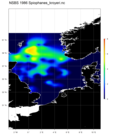| Introduction | | Species lists | | Search taxa | | Taxon tree | | Literature | | Distributions | | Statistics | | Editors | | Match taxa | | Webservice | | Log in |
WoRMS taxon detailsSpiophanes Grube, 1860
129626 (urn:lsid:marinespecies.org:taxname:129626)
accepted
Genus
Spiophanes kroyeri Grube, 1860 (type by monotypy)
Morants Chamberlin, 1919 · unaccepted (subjective synonym)
marine,
recent only
Grube, A.E. (1860). Beschreibung neuer oder wenig bekannter Anneliden. Fünfter Beitrag. Archiv für Naturgeschichte, Berlin. 26 (1): 71-118, plates III-V., available online at https://www.biodiversitylibrary.org/page/7153453
page(s): 88 [details]
Note Type species S. kroyeri Grube 1860.
From editor or global species database
Type species Type species S. kroyeri Grube 1860. [details]
Etymology Not stated. The name Spiophanes seems to be composed by the generic name Spio Fabricius, 1785, the type genus of the family...
Etymology Not stated. The name Spiophanes seems to be composed by the generic name Spio Fabricius, 1785, the type genus of the family Spionidae, followed by the Greek suffix phanes, which has many meanings relating to light, shining, visibility or distinctness (see Brown, 1954 'Composition of Scientific Words'; for example Nyctiphanes' is a night-visible crustacean) and presumably relates in some way Spiophanes kroyeri Grube, 1860, the type of the new genus, as similar but distinct from the species in the genus Spio: ''Diese neue Gattung gehört jedenfalls in die Nähe von Nerine und Spio'' (Grube, 1860: 89). Phanes as a separate name is also the name of the Greek mythology masculine primeval deity of procreation and the generation of new life, but this link seems unlikely to apply to the usage here. [details]
Read, G.; Fauchald, K. (Ed.) (2024). World Polychaeta Database. Spiophanes Grube, 1860. Accessed through: World Register of Marine Species at: https://www.marinespecies.org/aphia.php?p=taxdetails&id=129626 on 2024-11-14
Date action by
original description
Grube, A.E. (1860). Beschreibung neuer oder wenig bekannter Anneliden. Fünfter Beitrag. Archiv für Naturgeschichte, Berlin. 26 (1): 71-118, plates III-V., available online at https://www.biodiversitylibrary.org/page/7153453
page(s): 88 [details] original description (of Morants Chamberlin, 1919) Chamberlin, Ralph V. (1919). New polychaetous annelids from Laguna Beach, California. <em>Journal of Entomology and Zoology of Pomona College.</em> 11(1): 1-23., available online at http://biodiversitylibrary.org/page/12263520 page(s): 17 [details] additional source Meißner, Karin and Hutchings, Patricia A. 2003. Spiophanes species (polychaeta: Spionidae) from eastern Australia: with descriptions of new species, new records and an emended generic diagosis. Records of the Australian Museum, 55(2): 117-140. [details] additional source Meißner, Karin. (2005). Revision of the genus <i>Spiophanes</i> (Polychaeta, Spionidae); with new synonymies, new records and descriptions of new species. <em>Mitteilungen aus dem Museum für Naturkunde in Berlin, Zoologische Reihe.</em> 81(1): 3-65., available online at http://doi.org/10.1002/mmnz.200310001 [details] Available for editors additional source Fauchald, K. (1977). The polychaete worms, definitions and keys to the orders, families and genera. <em>Natural History Museum of Los Angeles County: Los Angeles, CA (USA), Science Series.</em> 28:1-188., available online at http://www.vliz.be/imisdocs/publications/123110.pdf [details] additional source Bellan, G. (2001). Polychaeta, <i>in</i>: Costello, M.J. <i>et al.</i> (Ed.) (2001). European register of marine species: a check-list of the marine species in Europe and a bibliography of guides to their identification. <em>Collection Patrimoines Naturels.</em> 50: 214-231. (look up in IMIS) [details] additional source Day, J. H. (1967). [Sedentaria] A monograph on the Polychaeta of Southern Africa. Part 2. Sedentaria. British Museum (Natural History), London. pp. 459–842., available online at http://www.biodiversitylibrary.org/bibliography/8596 [details] additional source Meißner, Karin; Bick, Andreas; Müller, Carsten H. G. 2012. Parapodial glandular organs in Spiophanes (Polychaeta: Spionidae) studies on their functional anatomy and ultrastructure. Journal of Morphology 273(3): 291-311. [details] identification resource Meißner, Karin. (2005). Revision of the genus <i>Spiophanes</i> (Polychaeta, Spionidae); with new synonymies, new records and descriptions of new species. <em>Mitteilungen aus dem Museum für Naturkunde in Berlin, Zoologische Reihe.</em> 81(1): 3-65., available online at http://doi.org/10.1002/mmnz.200310001 [details] Available for editors  Present Present  Inaccurate Inaccurate  Introduced: alien Introduced: alien  Containing type locality Containing type locality
From editor or global species database
Diagnosis Original diagnosis by Grube (1860: 88): ''Corpus vermiforme, subteres, segmentis brevibus. Lobus capitalis segmento buccali penitus impressus, postice attenuatus , tentaculo postico brevi 1, oculis nullis. Segmentum buccale setis nudum, cirris tentacularibus 2 dorsualibus, labo capitali distentis. Pharynx exsertilis brevis (?). Fasciculi setarum utrinque distichi, e basi labii foliacei progerminantes, segmentorum omnium subaequales, nec vero in omnibus pariter locati, in prioribus dorsuales, in ceteris ad latera descendentes. Setae simplices, uncini nulli.''[details] Etymology Not stated. The name Spiophanes seems to be composed by the generic name Spio Fabricius, 1785, the type genus of the family Spionidae, followed by the Greek suffix phanes, which has many meanings relating to light, shining, visibility or distinctness (see Brown, 1954 'Composition of Scientific Words'; for example Nyctiphanes' is a night-visible crustacean) and presumably relates in some way Spiophanes kroyeri Grube, 1860, the type of the new genus, as similar but distinct from the species in the genus Spio: ''Diese neue Gattung gehört jedenfalls in die Nähe von Nerine und Spio'' (Grube, 1860: 89). Phanes as a separate name is also the name of the Greek mythology masculine primeval deity of procreation and the generation of new life, but this link seems unlikely to apply to the usage here. [details] Grammatical gender Unresolved. Spiophanes has been treated as masculine by modern authors, notably by Meißner, the revisor of the genus, but variably by earlier authors without any of them overtly stating the gender (Hartman created both masculine and feminine adjectival names). Spio itself is feminine, named after a female mythological entity. Foster (1971: 40) states the genus Spiophanes is masculine, without more detail as to why, and perhaps this has influenced later workers. The ICZN code has no guidance on gender treatment of -phanes used as a suffix. [details] Type species Type species S. kroyeri Grube 1860. [details] |


